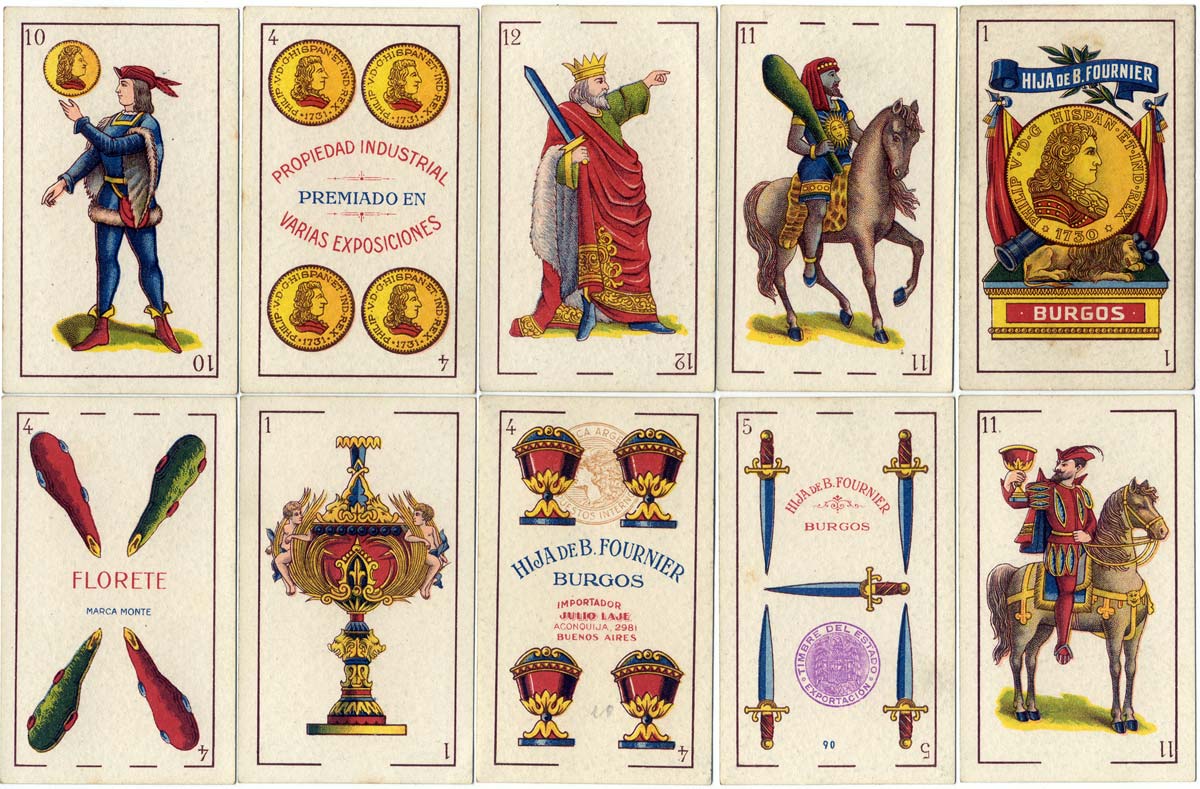Fournier Hnos Burgos
In 1860 the Fournier Brothers of Burgos (Spain) commenced producing playing cards. They produced high quality playing cards bearing a portrait of King Charles IV on the ace of coins.
Fournier Hnos Burgos, 1860
In 1860 the Fournier Brothers of Burgos (Spain) - Braulio, Julián, Gervasio and Heraclio - commenced producing playing cards. Having acquired lithographic machines from Paris, they produced high quality playing cards bearing a portrait of King Charles IV on a medallion, above a sleeping lion and a cannon, on the ace of coins. Their playing cards earned them the title "Lithographers of the Royal Household" from Queen Isabel II, as shown on the four of cups below. The youngest brother was called Heraclio Fournier. In 1868, at the age of nineteen, he left the family home and business in Burgos and moved north to Vitoria to establish himself as a printer and maker of playing cards. more...


Above: cards from two different sets produced lithographically by the Fournier Brothers, Burgos c.1860. The medallion on the Ace of Coins shows an image of Carlos IV.
Over time, as events unfolded, the company underwent several changes of name. The firm ended up in the hands of one remaining brother, Braulio. Braulio Fournier de Burgos, Litógrafo de la Casa Real was followed, on Braulio's death in 1888, by Viuda de Braulio Fournier, which in turn was succeeded by Hijos de B. Fournier. Of the five surviving descendants of Braulio's second marriage, Teresa becomes the new company director and the name is changed to Hija de B. Fournier. The company continues to be managed by the next generation of Fourniers at the same location as the original business first set up in 1860 and as well as producing playing cards, postage stamps were also produced during the civil war period. The business was finally closed down in 1978.

Above: cards from a pack of 'Florete' playing cards produced by Hija de B. Fournier, Burgos c.1930. The designs of the cards have been revised but the dark skinned figures on the clubs are still present. The ace of coins now contains a bust of Philip V. more →

By Simon Wintle
Member since February 01, 1996
I am the founder of The World of Playing Cards (est. 1996), a website dedicated to the history, artistry and cultural significance of playing cards and tarot. Over the years I have researched various areas of the subject, acquired and traded collections and contributed as a committee member of the IPCS and graphics editor of The Playing-Card journal. Having lived in Chile, England, Wales, and now Spain, these experiences have shaped my work and passion for playing cards. Amongst my achievements is producing a limited-edition replica of a 17th-century English pack using woodblocks and stencils—a labour of love. Today, the World of Playing Cards is a global collaborative project, with my son Adam serving as the technical driving force behind its development. His innovative efforts have helped shape the site into the thriving hub it is today. You are warmly invited to become a contributor and share your enthusiasm.
Related Articles

Tarot de las Coscojas
Historical playing card design, tarot symbolism and an almost psychedelic medieval surrealism.

Tarot de Valverde de la Vera
A series of 24 surrealist engravings by Mexican artist Claudio Favier in which archetypal Tarot alle...

Baraja de Juan Martín Zamorano
Deck inspired by El Pendón de los Zamorano, a military pennant dating from 1501, published by Priego...

Heráldica Castanyer No. 16
Strange variant of international pattern cards for poker or bridge.

Fantasy Spanish-suited deck
Fantasy Spanish-suited deck by Bertschinger y Codina, Barcelona.

Bertschinger y Codina - Cartes Françaises
French ‘Paris’ pattern made by Bertschinger y Codina, Barcelona, c.1850.

Braulio Fournier
Baraja Nº 1 produced by Braulio Fournier, Burgos, c.1868.

Pirritx eta Porrotx
Happy Families card game from the Spanish Basque Country.

Naipe Vizcaino
‘Naipe Vizcaino’ designed by Javier Urkiri and published by Industrias Gráficas Castuera and the Caj...

Baraja Turística del País Vasco
Basque poker deck of 55 cards published by Fournier with scenic views of the Basque Country.

Baraja Vasca
Spanish Basque Country deck with original drawings by María Isabel Ibañez de Sendadiano.

Baraja Cultura Española
ASESCOIN pack for 2022 designed by M.A. Corella featuring famous Spaniards and notable buildings.

Laurenzo Propagine
Spanish-suited cards made in Italy by Laurenzo Propagine.

Jeu de 7 familles Les Dynasties d’Artisans Basques
Long-standing Basque businesses represented in a traditional card game with illustrations by Odile A...

Archaic Franco-Spanish pattern
Archaic Franco-Spanish pattern by Guillaume & Jean Grossard (Bordeaux).

La Baraja del Mundial
“La Baraja del Mundial” satirical football deck published by Fournier for ‘Interviú’ news magazine. ...
Most Popular
Our top articles from the past 28 days

